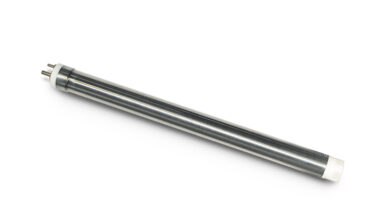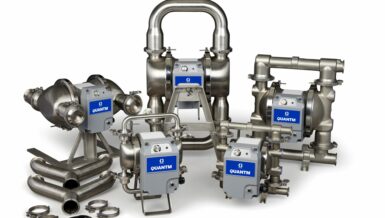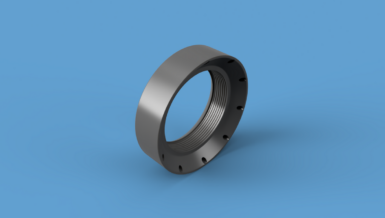Introduction Pumps are the very heart of fluid-transfer operations. Unexpected failure can devastate production and profits. Operators in the industrial-manufacturing realm have been looking for ways to see into the future, to know when, how and why a pump will need to be serviced before a catastrophic breakdown will bring a halt to the production process.
Over the years, manufacturers have worked to improve pump reliability and have developed tools to monitor pump performance and health. However, these tools typically result in little more than a “check engine light” scenario – You know there’s a problem, now what?
There is, however, a new pump diagnostic technology – SafeGuard™ – available from Griswold™ that allows the pump and driving motor to be monitored 24/7 via continuous Cloud connectivity. This article will illustrate how the SafeGuard technology works and how it can be a true game-changer in optimizing industrial-pump performance, reliability and cost of operation and maintenance.
The Challenge
In most industrial production and processing operations any unexpected failures can be devastating to the production schedule and, by extension, the operator’s bottom line. The negatives associated with pump failures are many:
- Disrupted production
- Batch failures
- Excessive downtime
- Costly repairs
- Costs for new parts and shipping
- Costs for service calls, which can include overtime
- Most critically, lost or compromised revenue
In many cases, failure can be prevented if the pump is installed and operated correctly. At the most basic, operators must take great care to ensure that the pump is properly aligned, operating without cavitation, has properly lubricated bearings, sufficient baseplate rigidity and more. Getting these wrong will lead to costly, yet preventable, repairs.
When a pump failure occurs, replacing the broken component alone may not be sufficient. Getting to the root cause can also be difficult and time consuming. As an example, if a mechanical seal fails, simply replacing it may not prevent a repeat failure if there is a shaft vibration issue that needs to be resolved. Pinpointing a root cause can lead to hours of if/ then assumptions and trial and error, along with the chasing of symptoms that may ultimately require a level of expertise that can only be provided by a (costly) third-party source.
Furthermore, if the pump is in a remote location, the level of complexity that is required to keep it operating reliably is ratcheted up. In these types of installations, it is difficult to monitor the pump without having a technician sent to the site, which brings its own added costs and safety issues.

Current Industry Solutions
Facilities have focused on deploying predictive maintenance (PdM) techniques as a solution to increasing production reliability since the 1990s. In the pump industry, PdM utilized techniques such as vibration and temperature monitoring to observe a pump’s performance and health during operation. Early on, PdM was a manual process where measurements were taken by hand-held devices and manually documented and analyzed. This process relied on vibration experts to interpret the data.
Over time, the pump industry has taken baby steps to deploying advanced technology in PdM as a way to help automate the process. While the current technologies have automated the data collection, they still have significant limitations:
- Complete Machine Monitoring: most technologies are designed to monitor the pump only, even though the pump is only part of the machine. These technologies ignore the health of the motor.
- Not true remote monitoring: the majority of “remote” monitoring technologies require technicians to be within Bluetooth® range of the pump with a mobile device to accurately gather the data.
- No real-time data: due to the remote monitoring restrictions, this not only fails to provide real-time data, but also 24/7 monitoring.
- Alarm only: the data collected by other diagnostic technologies is equivalent to an alert only with no clear level of urgency. Something is wrong, but what is it and when did it occur?
- No repair guidance: while there is an alert to signify a problem, the root cause is not identified nor any repair guidance offered.
- No single-source data collection: it is cumbersome to collect the data on all machines within the plant in one easy-to-reference and accessible location.
The NEW Solution

When compared to the capabilities of existing predictive pump-monitoring systems, the new SafeGuard diagnostic technology from Griswold, is an undeniable step forward. SafeGuard is the all-inclusive predictive-monitoring system that identifies failure modes and provides actionable repair guidance, monitoring both the pump and motor 24/7 with Wi-Fi or cellular access.
How does it work? The SafeGuard system consists of four battery-powered sensors. Two sensors are installed on the pump and two are installed on the motor. All four sensors work in unison to predict the full health of the pump and motor. This capability allows a complete diagnostic reading and analysis of a number of critical performance parameters for the pump, motor, coupling and foundation, including:
- Tri-Axial Vibration Reading: The equipment’s vibration signature produces extensive details regarding its health and can be used to identify impending bearing failure, misalignment, cavitation levels, pipe strain and more.
- Temperature Reading: Elevated operational temperatures are a sure indication of upcoming bearing failure, inadequate bearing lubrication, and other causes. Studying temperature trends can help the operator detect thermal-fault signatures, which will provide additional insight into when potential breakdowns may occur.
- Electromagnetic Reading: The Sensors are able to monitor the pump motor’s true RPM and proactively diagnose electrical faults, which will also enhance vibration-analysis accuracy.
This data is collected in real time by the sensors, compiled by the node and transferred to the Cloud to be analyzed, using the full capabilities of the Industrial Internet of Things (IIoT). The data is analyzed by a series of machine-learning algorithms that have been designed to determine the overall health level of the pump and motor, define the root cause of any alerts, and generate steps to resolve the issue.
All information can be quickly accessed by logging into the SafeGuard website. The system contains strategic dashboards to highlight the health of all pumps that are being monitored. Details about the pump, health trends and service recommendations can be accessed at a glance. Additionally, the analyst platform provides full access to view and evaluate the raw data.
When a potential issue is identified, the SafeGuard system will notify the operator via an automated email report, identifying the level of alert (whether it needs to be handled immediately or it’s something to be aware of), the root cause, as well as actionable resolution guidance. The SafeGuard system is able to identify more than 20 failure modes and counting. Such failure modes include bearing failure, coupling misalignment, cavitation, foundation looseness, and much more (details can be found on the SafeGuard website www.psgdover.com/ SafeGuard).
Having the capability to identify an issue, the level of urgency, root cause and repair guidance not only allows plant operators to be strategic in their maintenance schedules, but also can save an operator well more than $100,000 in operation/ maintenance costs over the lifetime of a pump. The chart below shows the average costs of equipment and services that can be avoided if the SafeGuard monitoring technology is properly utilized:

While the SafeGuard technology is the new gold standard in predictive intelligence gathering, other brands are making similar claims. As the chart below illustrates, these brands cannot offer the exhaustive list of capabilities that are inherent in the SafeGuard system:

Does it Really Work?
Although SafeGuard was qualified in a test facility, the proof comes from the field. The experience of one installation that utilized SafeGuard for over a year tells it all. A SafeGuard system was installed on a new ANSI centrifugal pump used in a chilled water loop for a steel-coating company. Upon installation, the maintenance team completed a startup checklist. The pump was put into service and SafeGuard immediately identified two issues: misalignment and foundation looseness. The cause of foundation looseness was identified immediately as a foundation bolt had come loose. Shocked by the misalignment alert, the maintenance team rechecked alignment with a laser alignment tool and found there indeed was an issue. After correcting these issues, the pump began operating acceptably. If these issues had not been caught in their early stages, the pump would have failed prematurely. After operating acceptably for 11 months, a new alert was identified. SafeGuard identified an electrical fault in the motor that would lead to motor failure. The customer was alerted of this fault and was able to replace the motor before a complete failure occurred.
Conclusion
There’s little doubt that advances in predictive analytics and technologies have put optimized IIoT solutions within reach for industrial manufacturers. A clear leap ahead in this area is Griswold’s SafeGuard, which takes existing pump diagnostic technology and creates a holistic way of looking at the pump and motor and the linkage between them that makes their operation part of one interconnected system. SafeGuard’s capabilities help optimize pump and motor uptime while increasing their lifespan and operational safety. This will result in fewer accidents that can have a negative impact on site personnel and the surrounding environment, while simultaneously meeting the demanding needs of production schedules and quotas, efficiency, maintenance, repair and replacement costs, spare-parts inventory and – most notably – revenue optimization.
About the Author: James Farley is the Product Manager for Griswold® and PSG®. He can be reached at james.farley@psgdover.com. Griswold, Grand Terrace, CA, USA, is a premier manufacturer of centrifugal pumps and baseplate systems from PSG, a Dover company. Headquartered in Oakbrook Terrace, IL, USA, PSG is comprised of several of the world’s leading pump brands, including Abaque™, All-Flo, Almatec®, Blackmer®, Ebsray®, EnviroGear®, Griswold®, Mouvex®, Neptune™, Quattroflow™, RedScrew™ and Wilden®. For more information on Griswold or PSG, please go to griswoldpump.com or psgdover.com. SafeGuard is a registered trademark of PSG. SafeGuard is powered by Augury, Inc. For more information on SafeGuard, visit www.psgdover.com/SafeGuard










